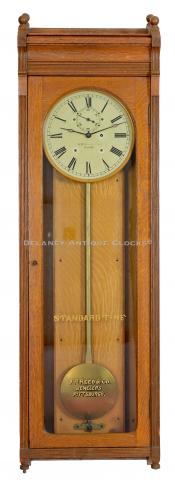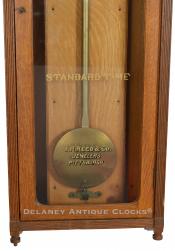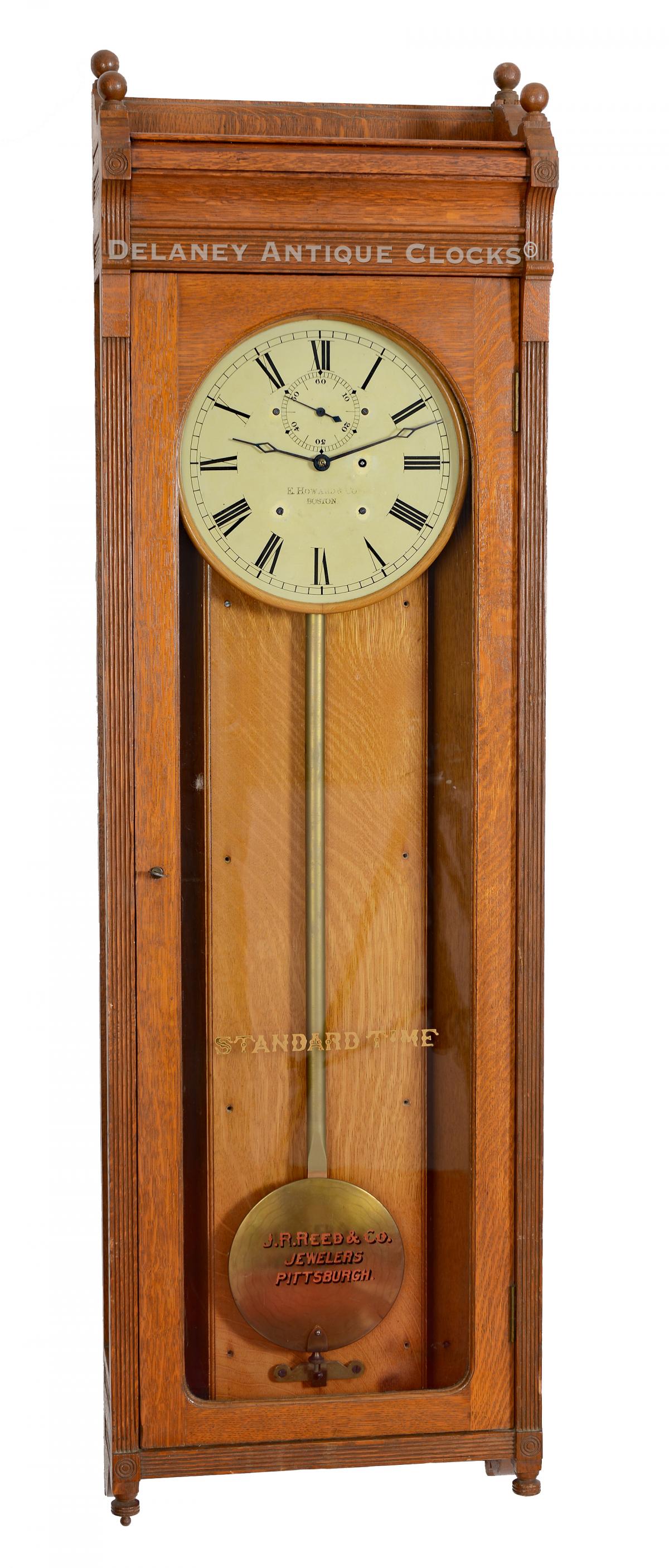E. Howard Clock Company. Boston Massachusetts. The Model No. 89. Railroad Regulator. 223304.
The E. Howard Clock Company claimed in their sales literature that Railroad Regulators are, as a rule, subjected to more exposure to the changes of weather than almost any other regulator in use. As a result, they must be as accurate and reliable as those in service in less exposed positions. The construction of this walnut example is designed to have minimal effect due to changes that result in expansion, contraction, and wrapping caused by wet and dry, warm and cold weather. These elements changes will have little effect on the model 89’s time-keeping ability. This model was specially designed for commercial applications and was used extensively by jewelers, watchmakers, and train dispatchers. It was advertised by the E. Howard firm as .”... the best regulator value on the market,” selling for $75.00 in and about 1900.
This model was first introduced in January of 1888 when 68 clocks were ordered by the Erie Railroad. These clocks were to be set up in the stations on their rail line, including the New York Line, the Erie, PA Line, and the Western Railroad Line. At first, they were referred to as “Erie Regulators.” The name changed in July of 1888 when they were referred to as the “No. 89.”
The Model 89’s ability to keep very good time was tested in August of 1889. Ten regulators were tested and observed. These were located on the following railroad lines: the Buffalo, B. & S. W., the Niagara Falls division of the New York Line, the Lake Erie Line, and the Western Railroads. These ten clocks had an average variation from the mean of only 8.9 seconds over a period of a month’s time. The greatest variation was measured at 24 seconds on a clock located in the Wabash Station in Moberly, Missouri. It ran 18 days right on time and 30 days with only three seconds of variation. A clock at the Union Depot in Cleveland, Ohio, ran 16 weeks with an extreme variation of only 3 seconds in any one week. As a result, this model has developed a reputation for being a very sound timekeeper.
This is an excellent example that features a classic finish. The case is constructed in oak and displays a number of decorative details, including the reeded moldings and turned finials. The large door, located on the front of the case, is fitted with a large piece of clear glass. This glass retains the original advertisement of “STANDARD TIME,” written across the middle in stylized lettering. It is also decorated with the retailer’s firm name. This advertising reads, “J.R.Reed & Co. / JEWELERS / PITTSBURGH.” J. R. Reed & Co. ordered many clocks from the Howard Company. They often specified that Howard put their name on the glass or even the dial. It can be considered a real plus to have this graphic remaining on the glass. Through this door, one can view the painted dial, which the Maker signs “E. Howard & Co. / BOSTON.” in block lettering. The painted zinc dial measures 12 inches in diameter and is original to this clock. It features Roman hour numerals and a subsidiary seconds dial. This dial is trimmed with an oak bezel or ring and mounts directly to the movement via four posts. The pendulum rod is made of seasoned cherry. The rod retains its original gilding. This rod supports the large brass-covered bob that is filled with zinc for compensation. The brass is decorated with an engine-turned design.
The weight-driven movement is very good quality. It is framed with two large brass rectangular-shaped plates. The front plate is die-stamped by the Maker in the upper left-hand corner. The die-stamp reads “E. Howard & Co. / BOSTON / 1.” The movement (photographed before servicing) is designed to run for eight days on a single wind. It features a Graham Dead Beat Escapement and maintaining power. The movement is wound with a crank key. A Geneva Stop prevents one from overwinding this clock. The weight falls directly below the movement. It is hidden from view by the wooden channel constructed inside the case.
This is a large and impressive clock. The case measures 65 inches long by 19 & 5/8 inches wide and 6 & 7/8 inches deep. It was made in 1905.
Inventory number 223304.
The E. Howard & Company succeeded the Howard & Davis firm in 1857. The Howard & Davis firm was comprised of Edward Howard and David Porter Davis and was established in 1842 in Roxbury, Massachusetts. Both men had just completed their clock apprenticeship under the guidance of Aaron Willard Jr in Boston. The Howard & Davis firm made high-grade clocks, precision balances, sewing machines, fire engines, and watches. After the dissolution of Howard & Davis, Edward Howard became Boston's leading manufacturer of weight-driven residential and commercial clocks. The firm also made a large number of tower clocks and watchman and salve clock systems. These sold well in the last quarter of the 1800s.
It has been said that the E. Howard Clock company never made an inexpensive clock, and everything they made was of very good quality. As a result, Howard clocks have become very collectible and are prized by their owners. Today, the E. Howard name enjoys outstanding name recognition.
For a more in-depth reading of Edward Howard and his various businesses, please read "Willard's Patent Time Pieces," written by Paul Foley.












